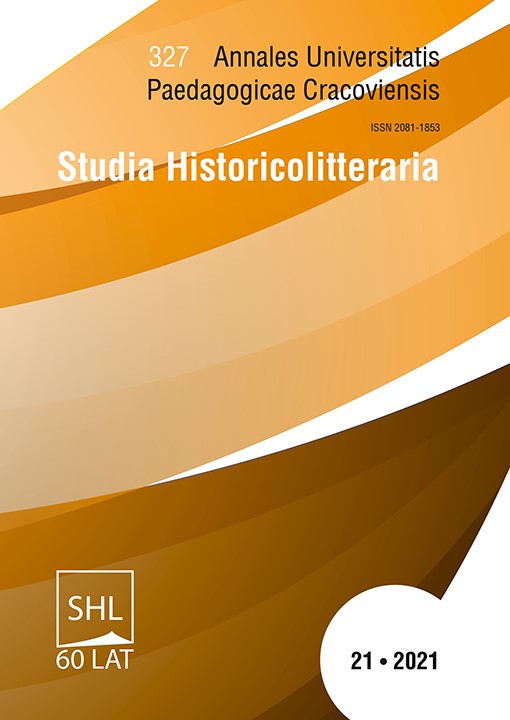The image of Poland and Poles in Spanish chivalric romances
Main Article Content
Abstract
The geography of the world presented in Spanish chivalric romances combines real spaces or areas inspired by them with others, completely made-up, purely born in the author’s imagination. As a rule, toponyms used in the chronicles of adventures of knights-errant are not meant to inform the reader about the characteristics of the place in which the action unfolds. Wherever the adventure happens: a sinking ship, a battlefield, a duel location or a magical trial, the focus point is the protagonist, not the place. However, authors of chivalric romances use numerous toponyms and do not refrain from mentioning countries that are
less familiar to their readers in order to introduce a certain diversity and make their work stand out in the swarm of other publications. In this way, the toponym “Poland” appears in the stories of knights-errant, sometimes as the location of the adventure, but most often as the homeland of warriors who are frequently becoming friends with the main character. This article analyses the image of Poland and Poles as outlined by the authors of chivalric romances, both where the area performs a purely episodic function and when it becomes one of the most important places in the geography of the fictional world. The author also
hypothesises about the possible sources of inspiration for describing the territory of Poland and her inhabitants.
Downloads
Article Details

This work is licensed under a Creative Commons Attribution-NonCommercial-NoDerivatives 4.0 International License.
COPYRIGHT POLICY
The publisher of "Annales Universitatis Paedagogicae Cracoviensis.Studia Historicolitteraria" is authorised to use and distribute all the materials published in the journal on the basis of a non-exclusive licence agreement unlimited in time – previously concluded for an indefinite period of time each time with the author of a specific paper in the fields of exploitation specified in the agreement.
OPEN ACCESS POLICY
"Annales Universitatis Paedagogicae Cracoviensis.Studia Historicolitteraria” is an open access journal, and all its contents are available for free to users and/or their institutions on the basis of non-exclusive licenses under Creative Commons (CC BY CC-BY-4.0). Users can read, download, make copies, distribute, print, search, or to link to full text articles in this journal without the prior permission of the publisher or the author.This is consistent with the definition of open access BOAI (http://www.soros.org/openaccess).
References
Anderson G., Introduction, [en:] La corónica de Adramón, Part I, Newark, Delaware 1992, pp. I–LVIII.
Bajtín M., La novela como género literario, trad. C. Ginés Orta, Zaragoza 2019.
Baldo, ed. de F. Gernert, Alcalá de Henares 2002.
Cervantes M. de, Don Quijote de la Mancha I, ed. de J.J. Allen, Madrid 2011.
La corónica de Adramón, ed. de G. Anderson, Newark, Delaware 1992.
Fernández de Enciso M., Suma de geografía que trata de todas las partidas y provincias del mundo, Andres de Burgos, Sevilla 1546.
Guijarro Ceballos J., El ciclo de “Clarián de Landanís” [1518–1522–1524–1550], “Edad de Oro” 2002, vol. 21, pp. 251–270.
Lucía Megías J.M., De los libros de caballerías manuscritos al Quijote, Madrid 2004.
Lucía Megías J.M., Notas sobre el códice y la fecha de la “Crónica de Adramón”, [en:] Fechos antiguos que los cavalleros en armas pasaron. Estudios sobre la literatura caballeresca, ed. J. Acebrón Ruiz, Lleida 2001, pp. 41–60.
Marín Pina M. C., Los libros de caballerías en el espacio y el espacio en los libros de caballerías, [en:] Espacios en la Edad Media y el Renacimiento, ed. M. Morrás Ruiz-Falcó, Salamanca 2018, pp. 87–139.
Martínez Muñoz A., Geografía y libros de caballerías. Martín Fernández de Enciso, Jerónimo de Chaves y Paolo Giovio como fuentes de la cartografía caballeresca, “Historias fingidas” 2017, n. 5, pp. 3–23.
Martorell J., Tirant Biały I, trad. R. Sasor, Kraków 2007.
Martorell J., Tirant lo Blanc, ed. de M. de Riquer, Barcelona 2006.
Najera A. de, Navegacion especulativa y pratica, Lisboa 1628.
Ortega M. de, Felixmarte de Hircania, ed. de M. del Rosario Aguilar Pardomo, Alcalá de Henares 1998.
Ortúñez de Calahorra D., Espejo de príncipes y cavalleros: el cavallero del Febo, libros I–IV, ed. de D. Eisenberg, Madrid 1975.
Ramos Nogales R., Dos nuevas continuaciones para el «Espejo de príncipes y caballeros», “Historias fingidas” 2016, n. 4, pp. 41–95.
Romero Tabares I., Constantinopla como espacio mítico-fantástico en la saga de los amadises, [en:] Actas del XI Congreso Internacional de la Asociación Hispánica de la Literatura Medieval, ed. A. López Castro y L. Cuesta Torre, León 2007, pp. 1003–1010.
Roubaud S., Calas en la narrativa caballeresca renacentista: el Belianís de Grecia y el Clarián de Landanís, [en:] La invención de la novela, ed. J. Canavaggio, Madrid 1999, pp. 49–84.
Sales Dasí E.J., Literatura de viajes y libros de caballerías: la “Crónica de Adramón”, [en:] Maravillas, peregrinaciones y utopías: literatura de viajes en el mundo románico, ed. R. Beltrán Llavador, Valencia 2002, pp. 385–409.
Sánchez-Martí J., The Printed Popularization of the Iberian Books of Chivalry Across Sixteenth-Century Europe, [en:] Crossing Borders, Crossing Cultures, ed. M. Rospocher, J. Salman y H. Salmi, Berlin 2019, pp. 159–180.
Setkowicz K., Ruxia i Ruxianos w romansach rycerskich autorstwa Feliciano de Silva, “Eslavística Complutense” 2015, n. 15, pp. 9–20.
Siria P. de, Arte de la verdadera navegación, Valencia 1602.
Urrea J. de, Primera parte del libro del invencible caballero don Clarisel de las Flores y de Austrasia, Sevilla 1879.
Z przygód imć pana Amadisa z Walii, jako też innych druhów jego, trad. R. Jarocka-Nowak y A. Nowak, Kraków 1998.
